Why Is Sleep Testing Important for Diagnosing Sleep Disorders?
Sleep testing provides the objective medical data needed to accurately identify sleep disorders that affect millions of people worldwide. Without proper diagnostic testing, conditions like sleep apnoea, narcolepsy, and periodic limb movement disorder often go undetected despite causing significant health problems.
The Role of Sleep Testing
The importance of sleep test lies in its ability to capture what happens during sleep—a time when patients cannot self-monitor their symptoms. Through methods like polysomnography, medical professionals record brain waves, breathing patterns, oxygen levels, heart rate, and body movements throughout the night. This comprehensive data reveals disruptions invisible during waking hours.
The Consequences of Undiagnosed Sleep Disorders
Timely diagnosis of sleep disorders prevents minor symptoms from escalating into serious health complications. The longer sleep disorders remain undiagnosed, the greater the risk of developing:
- Cardiovascular disease
- Type 2 diabetes
- Cognitive impairment
- Chronic fatigue
- Depression and anxiety
The Benefits of Early Intervention
Booking a sleep testing appointment sooner rather than later creates opportunities for early intervention, enabling treatment plans that restore healthy sleep patterns before irreversible damage occurs.
What Are the Common Sleep Disorders Diagnosed Through Sleep Testing?
Polysomnography remains the gold standard for diagnosing sleep disorders, recording brain waves, oxygen levels, heart rate, breathing patterns, and eye and leg movements during overnight stays at sleep centres. A home sleep apnea test offers a convenient alternative, using portable sensors to monitor breathing and oxygen levels in your own bed.
These diagnostic tools detect several critical conditions:
- Sleep apnea – characterised by repeated breathing interruptions during sleep
- Periodic limb movement disorder – involuntary leg movements that disrupt rest
- Narcolepsy – sudden sleep attacks and excessive daytime drowsiness
- REM sleep behavior disorder – physical acting out of dreams during REM sleep
The tests capture vital physiological data throughout different sleep stages. Brain wave monitoring reveals abnormal sleep architecture, whilst respiratory sensors identify breathing cessations or shallow breathing episodes. Oxygen saturation measurements detect dangerous drops in blood oxygen levels, and movement sensors track physical disturbances that fragment sleep quality. This comprehensive data collection enables precise narcolepsy diagnosis and identification of other complex sleep disorders that symptoms alone cannot confirm.
How Can Untreated Sleep Disorders Affect Overall Health?
Untreated sleep disorders create serious health consequences that extend far beyond feeling tired. The cardiovascular impact of sleep apnea includes elevated blood pressure, increased risk of heart attacks, and stroke due to repeated oxygen deprivation during sleep.
Physical Health Complications:
- Chronic high blood pressure from interrupted breathing patterns
- Greater likelihood of developing type 2 diabetes and sleep issues
- Weakened immune system function
- Increased inflammation throughout the body
Mental and Cognitive Effects:
The untreated sleep disorders risks manifest in daily functioning through persistent brain fog, memory problems, and difficulty concentrating. Mood disturbances become common, with irritability, anxiety, and depression affecting relationships and work performance. Productivity plummets as the brain struggles without adequate restorative sleep.
Delayed diagnosis allows these conditions to compound. Sleep apnea worsens gradually, causing more severe oxygen drops and placing greater strain on vital organs. The longer treatment waits, the more entrenched these health problems become, making recovery more challenging and potentially causing irreversible damage to cardiovascular and metabolic systems.
Why Does Early Diagnosis Through Sleep Testing Matter?
Early diagnosis benefits become apparent when sleep disorders are caught before they progress into more severe conditions. Detecting issues like sleep apnea or periodic limb movement disorder in their initial stages prevents the cascade of health complications that develop over months and years of disrupted sleep.
Timely treatment for sleep disorders opens multiple intervention pathways:
- CPAP machines that maintain continuous airway pressure throughout the night
- Oral appliances designed to reposition the jaw and keep airways open
- Lifestyle modifications including weight management and sleep position changes
- Surgical options for structural abnormalities causing breathing obstructions
Prompt intervention transforms daily functioning. Patients report sharper mental clarity, stable moods, and renewed energy within weeks of starting treatment. Work performance improves as concentration returns. Relationships strengthen when irritability and fatigue no longer dominate interactions. The improved health outcomes extend beyond symptom relief—early treatment reduces cardiovascular strain and metabolic dysfunction before permanent damage occurs.
What Should Patients Know About Preparing for a Sleep Test?
Proper sleep test preparation tips directly impact the accuracy of your diagnostic results. Your healthcare provider will instruct you to avoid alcohol and caffeine for at least 4-6 hours before testing, as these substances alter natural sleep patterns and can skew data collection.
For polysomnography preparation at a sleep centre, arrive with clean, dry hair free from styling products that might interfere with electrode placement. Bring comfortable sleepwear and any regular medications you take at bedtime. The technicians will attach sensors to monitor your brain activity, breathing, and movement throughout the night.
If you’re undergoing a home sleep test, it’s essential to follow the instructions carefully for equipment setup. You’ll receive a portable monitoring device with specific guidelines for:
- Placing the nasal cannula correctly to measure airflow
- Positioning chest and abdominal belts to track breathing effort
- Attaching the pulse oximeter to your finger for oxygen level readings
- Activating the device at your usual bedtime
Following these guidelines precisely ensures your test captures reliable data that healthcare professionals need to identify sleep disorders and recommend appropriate treatment options.

How Does Booking a Sleep Test Sooner Improve Treatment Planning?
Early sleep testing provides healthcare professionals with precise data to create personalised sleep disorder care strategies tailored to your specific condition. Detailed treatment planning from sleep test results begins the moment your test captures comprehensive information about sleep architecture, breathing irregularities, and movement patterns.
The benefits of obtaining this data quickly include:
- Targeted interventions – Knowing whether you experience shallow breathing, complete airway obstructions, or leg movements allows doctors to recommend the most effective treatment immediately
- Appropriate device selection – Test results determine if you need a CPAP machine, BiPAP device, or oral appliance, avoiding trial-and-error approaches
- Dosage accuracy – For conditions like narcolepsy, early data helps establish correct medication protocols from the start
Prompt testing also shapes long-term management strategies by establishing baseline measurements. Your healthcare team can track improvement over time, adjust treatments as needed, and prevent your condition from progressing to more severe stages that require invasive interventions like surgery.
Conclusion
Recognising the warning signs of sleep disorders—persistent snoring, daytime fatigue, breathing interruptions, or restless nights—demands immediate action. When you book sleep test early, you gain access to precise diagnostic data that shapes effective treatment strategies before complications escalate.
The evidence is clear: managing sleep disorders promptly prevents cardiovascular disease, metabolic dysfunction, and cognitive decline whilst restoring energy and productivity. Delaying evaluation only allows symptoms to intensify and health risks to multiply.
Take control of your sleep health today. Contact a sleep specialist to schedule your assessment and begin the journey towards restorative sleep and improved wellbeing. Your body deserves the comprehensive care that timely diagnosis provides.
More to Read : What Happens During a Sleep Study in Australia?
Frequently Asked Questions (FAQs) About Sleep Testing in Australia
Booking a sleep test early helps detect sleep disorders before they progress into more serious conditions. Early diagnosis allows for faster treatment of issues like sleep apnea, insomnia, and restless legs syndrome—preventing long-term complications such as heart disease, diabetes, and cognitive decline.
2. What are the warning signs that I might need a sleep test?
You should consider a sleep study if you experience:
Loud or frequent snoring
Breathing pauses during sleep
Morning headaches or dry mouth
Persistent daytime fatigue
Restless sleep or leg movements at night
Difficulty staying awake during work or driving
These symptoms often indicate underlying sleep disorders that require medical assessment.
3. What happens during a professional sleep test?
During a sleep test (polysomnography), sensors are attached to your scalp, face, chest, and legs to measure brain activity, oxygen levels, breathing effort, and heart rate. This non-invasive monitoring provides doctors with detailed data on how your body functions throughout the night.
4. How can untreated sleep disorders affect my health?
Leaving sleep disorders untreated increases the risk of:
Cardiovascular problems such as hypertension and heart disease
Metabolic issues like obesity and type 2 diabetes
Cognitive impairment and memory loss
Mood disorders, including depression and anxiety
Chronic fatigue, which affects productivity and safety
Early detection through testing helps prevent these complications.
5. What are the benefits of early sleep testing?
Early testing allows for timely diagnosis and personalised treatment. Benefits include:
Improved energy and alertness
Better mood stability and mental clarity
Reduced risk of heart disease and stroke
Enhanced work and relationship performance
Long-term protection against chronic health issues
6. What types of sleep tests are available in Australia?
You can undergo either:
In-lab sleep studies (polysomnography): Conducted overnight in a sleep centre with professional supervision.
Home sleep tests: Portable devices that record breathing and oxygen levels in your own bed—ideal for suspected sleep apnea.
7. How do I prepare for a sleep test?
Follow these preparation steps to ensure accurate results:
Avoid caffeine and alcohol 4–6 hours before the test
Don’t nap during the day
Arrive with clean, dry hair and no lotions on your skin
Bring comfortable sleepwear and your bedtime medications
For home studies, follow the setup instructions carefully to ensure proper sensor placement.
8. How long will it take to get my results?
Sleep test results in Australia are typically available within 1–2 weeks. Your sleep specialist will then explain your diagnosis, severity, and recommend treatment options such as CPAP therapy, oral appliances, or lifestyle changes.
9. Can delaying a sleep test make my condition worse?
Yes. Sleep disorders often worsen over time, leading to more frequent breathing interruptions, lower oxygen levels, and higher cardiovascular strain. The sooner testing occurs, the easier and more effective treatment will be.
10. Is a sleep study covered by Medicare or private insurance in Australia?
Yes. Medicare often covers sleep studies if you have a GP referral. Many private health funds also include coverage, depending on your policy. Always check with your provider before scheduling your appointment.
11. How does early diagnosis improve treatment outcomes?
Early diagnosis allows doctors to tailor your therapy precisely—whether that’s adjusting CPAP pressure levels, prescribing medication, or recommending lifestyle changes. This leads to quicker recovery, better sleep, and long-term protection against health deterioration.
12. What lifestyle changes can support better sleep after testing?
Maintain a consistent sleep schedule
Reduce caffeine and alcohol intake
Lose excess weight if overweight
Exercise regularly
Create a calm, dark, and quiet sleeping environment
These adjustments enhance the effectiveness of any prescribed therapy and support lasting improvements in sleep health.


